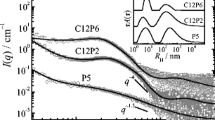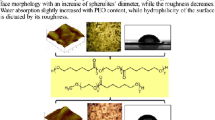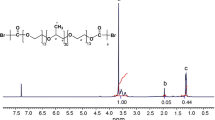Abstract
Here, cloud temperature and aggregation behaviors of poly(N-vinyl caprolactam)-based polymer were investigated with the addition of hydrophilic units. Copolymers composed of N-vinyl caprolactam and polyethyleneglycol methylacrylate (POEGMA) were firstly synthesized through a reversible addition fragmentation chain transfer technology with benzylsulfanylthiocarbonylsulfanyl propionic acid (BPA) as chain transfer agent and 4,4′-azobis(4-cyanovaleric acid) as initiator. The cloud points measurements indicated that comparing with pure poly(N-vinyl caprolactam), little amount of POEGMA would dramatically decrease copolymers’ cloud temperature while further addition of POEGMA would inversely increase the cloud temperature. The contribution of POEGMA within polymeric chains was modulated by adding POEGMA after 30 min of initiating polymerization. Both the DLS and TEM measurements showed that micelles instead of random structures were formed through a self-assembling process above the cloud temperature. These results emphasized the importance of the contribution of hydrophilic units in predicting the thermal phase transition behavior of poly(N-vinyl caprolactam)-based materials.

Graphical abstract









Similar content being viewed by others
References
Cortez-Lemus NA, Licea-Claverie A (2016) Poly(N-vinylcaprolactam), a comprehensive review on a thermoresponsive polymer becoming popular. Prog Polym Sci 53:1–51
Wang C, Wang X, Dong K, Luo J, Zhang Q, Cheng Y (2016) Injectable and responsively degradable hydrogel for personalized photothermal therapy. Biomaterials 104:129–137
Whittaker JL, Subianto S, Dutta NK, Choudhury NR (2016) Induced insolubility of electrospun poly(N-vinylcaprolactam) fibres through hydrogen bonding with tannic acid. Polymer 87:194–201
Wu QH, Tang XP, Liu X, Hou Y, Li H, Yang C, Yi J, Song XM, Zhang GL (2016) Thermo/pH dual responsive mixed-shell polymeric micelles based on the complementary multiple hydrogen bonds for drug delivery. Chem- Asian J 11:112–119
Lee H, Hoshino Y, Wada Y, Arata Y, Maruyama A, Miura Y (2015) Minimization of synthetic polymer ligands for specific recognition and neutralization of a toxic peptide. J Am Chem Soc 137:10878–10881
Agrawal G, Schuerings MP, van Rijn P, Pich A (2013) Formation of catalytically active gold-polymer microgel hybrids via a controlled in situ reductive process. J Mater Chem A 1:13244–13251
Beija M, Marty JD, Destarac M (2011) Thermoresponsive poly(N-vinyl caprolactam)-coated gold nanoparticles: sharp reversible response and easy tunability. Chem Commun 47:2826–2828
Liu J, Debuigne A, Detrembleur C, Jerome C (2014) Poly(N-vinylcaprolactam): a Thermoresponsive macromolecule with promising future in biomedical field. Adv Healthcare Mater 3:1941–1968
Lutz JF, Akdemir O, Hoth A (2006) Point by point comparison of two thermosensitive polymers exhibiting a similar LCST: is the age of poly(NIPAM) over? J Am Chem Soc 128:13046–13047
Shao L, Hu M, Chen L, Xu L, Bi Y (2012) RAFT polymerization of N-vinylcaprolactam and effects of the end group on the thermal response of poly(N-vinylcaprolactam). React Funct Polym 72:407–413
Burova TV, Grinberg NV, Grinberg VY, Kalinina EV, Lozinsky VI, Aseyev VO, Holappa S, Tenhu H, Khokhlov AR (2005) Unusual conformational behavior of complexes of poly(N-isopropylacrylamide) with poly(methacrylic acid). Macromolecules 38:1292–1299
Medeiros SF, Oliveira PFM, Silva TM, Lara BR, Elaissari A, Santos AM (2015) Biocompatible and multi-responsive poly(N-vinylcaprolactam)-based microgels: the role of acidic comonomers in the colloidal properties and phase transition as a function of temperature and pH. Eur Polym J 73:191–201
Maeda Y, Nakamura T, Ikeda I (2002) Hydration and phase behavior of poly(N-vinylcaprolactam) and poly(N-vinylpyrrolidone) in water. Macromolecules 35:217–222
Kirsh YE, Krylov AV, Belova TA, Abdelsadek GG, Pashkin II (1996) Transformations of poly-N-vinylcasprolactam in aqueous-organic mixtures. Zhurnal Fizicheskoi Khimii 70:1403–1407
Makhaeva EE, Tenhu H, Khokhlov AR (1998) Conformational changes of poly(vinylcaprolactam) macromolecules and their complexes with ionic surfactants in aqueous solution. Macromolecules 31:6112–6118
Xu YT, Cao Y, Xie JJ, Li Q, Chen XM, Kuo SW, Dai LZ (2016) Mixed micelles from synergistic self-assembly of hybrid copolymers with charge difference electrostatic interaction induced re-organization of micelles from hybrid copolymers. J Mater Res 31:2046–2057
Xu WN, Ledin PA, Iatridi Z, Tsitsilianis C, Tsukruk VV (2016) Multicompartmental microcapsules with orthogonal programmable two-way sequencing of hydrophobic and hydrophilic cargo release. Angew Chem Int Ed 55:4908–490+
Li GY, Qi MY, Yu NN, Liu XY (2015) Hybrid vesicles co-assembled from anionic graft copolymer and metal ions for controlled drug release. Chem Eng J 262:710–715
Liu F, Kozlovskaya V, Medipelli S, Xue B, Ahmad F, Saeed M, Cropek D, Kharlampieva E (2015) Temperature-sensitive polymersomes for controlled delivery of anticancer drugs. Chem Mater 27:7945–7956
Lou S, Gao S, Wang W, Zhang M, Zhang J, Wang C, Li C, Kong D, Zhao Q (2015) Galactose-functionalized multi-responsive nanogels for hepatoma-targeted drug delivery. Nanoscale 7:3137–3146
Sudhakar K, Rao KM, Subha MCS, Rao KC, Sadiku ER (2015) Temperature-responsive poly(N-vinylcaprolactam-co-hydroxyethyl methacrylate) nanogels for controlled release studies of curcumin. Des Monomers Polym 18:705–713
Wang Y, Zheng J, Tian YF, Yang WL (2015) Acid degradable poly(vinylcaprolactam)-based nanogels with ketal linkages for drug delivery. J Mater Chem B 3:5824–5832
Lou SF, Gao S, Wang WW, Zhang MM, Zhang QQ, Wang C, Li C, Kong DL (2014) Temperature/pH dual responsive microgels of crosslinked poly(N-vinylcaprolactam-co-undecenoic acid) as biocompatible materials for controlled release of doxorubicin. J Appl Polym Sci 131:7
Loos W, Verbrugghe S, Goethals EJ, Du Prez FE, Bakeeva IV, Zubov VP (2003) Thermo-responsive organic/inorganic hybrid hydrogels based on poly(N-vinylcaprolactam). Macromol Chem Phys 204:98–103
Ieong NS, Hasan M, Phillips DJ, Saaka Y, O’Reilly RK, Gibson MI (2012) Polymers with molecular weight dependent LCSTs are essential for cooperative behaviour. Polym Chem 3:794–799
Liang X, Liu F, Kozlovskaya V, Palchak Z, Kharlampieva E (2015) Thermoresponsive micelles from double LCST-poly(3-methyl-N-vinylcaprolactam) block copolymers for cancer therapy. ACS Macro Lett 4:308–311
Perrier S, Takolpuckdee P (2005) Macromolecular design via reversible addition-fragmentation chain transfer (RAFT)/xanthates (MADIX) polymerization. J Polym Sci Part a-Polym Chem 43:5347–5393
Jansen JFGA, Houben EEJE, Tummers PHG, Wienke D, Hoffmann J (2004) Real-time infrared determination of photoinitiated copolymerization reactivity ratios: application of the Hilbert transform and critical evaluation of data analysis techniques. Macromolecules 37:2275–2286
Qiu XP, Sukhishvili SA (2006) Copolymerization of N-vinylcaprolactam and glycidyl methacrylate: reactivity ratio and composition control. J Polym Sci Part a-Polym Chem 44:183–191
Shah S, Pal A, Gude R, Devi S (2010) Synthesis and characterization of thermo-responsive copolymeric nanoparticles of poly(methyl methacrylate-co-N-vinylcaprolactam). Eur Polym J 46:958–967
Federico Jasso-Gastinel C, Arnez-Prado AH, Jose Aranda-Garcia F, Octavio Sahagun-Aguilar L, Lopez-Dellamary Toral FA, Elena Hernandez-Hernandez M, Javier Gonzalez-Ortiz L (2017) Tailoring copolymer properties by gradual changes in the distribution of the chains composition using semicontinuous emulsion polymerization. Polymers 9
Zhang C, Xu T, Bao Z, Fu Z, Chen L (2017) Synthesis and characterization of polyacrylate latex containing fluorine and silicon via semi-continuous seeded emulsion polymerization. J Adhes Sci Technol 31:1658–1670
Wei D, Zhang Y, Fu J (2017) Fabrication of carbon nanospheres by the pyrolysis of polyacrylonitrile-poly(methyl methacrylate) core-shell composite nanoparticles. Beilstein J Nanotechnol 8:1897–1908
Vancoillie G, Frank D, Hoogenboom R (2014) Thermoresponsive poly(oligo ethylene glycol acrylates). Prog Polym Sci 39:1074–1095
Boyer C, Whittaker MR, Luzon M, Davis TP (2009) Design and synthesis of dual thermoresponsive and antifouling hybrid polymer/gold nanoparticles. Macromolecules 42:6917–6926
Zhang YJ, Furyk S, Bergbreiter DE, Cremer PS (2005) Specific ion effects on the water solubility of macromolecules: PNIPAM and the Hofmeister series. J Am Chem Soc 127:14505–14510
Funding
The authors are grateful for the Excellent Academic Leaders Foundation of Harbin, China (No. 2014RFXXJ017), and the Open Project of State Key Laboratory of Urban Water Resource and Environment, Harbin Institute of Technology (No. QA201610-02).
Author information
Authors and Affiliations
Corresponding author
Ethics declarations
Conflict of interest
The authors declare that they have no conflict of interest.
Additional information
Publisher’s note
Springer Nature remains neutral with regard to jurisdictional claims in published maps and institutional affiliations.
Electronic supplementary material
ESM 1
(DOCX 587 kb)
Rights and permissions
About this article
Cite this article
Peng, J., Tang, D., Lv, H. et al. Thermal phase transition of poly(N-vinyl caprolactam)-based copolymers: the distribution of hydrophilic units within polymeric chains. Colloid Polym Sci 297, 1255–1264 (2019). https://doi.org/10.1007/s00396-019-04537-y
Received:
Revised:
Accepted:
Published:
Issue Date:
DOI: https://doi.org/10.1007/s00396-019-04537-y




